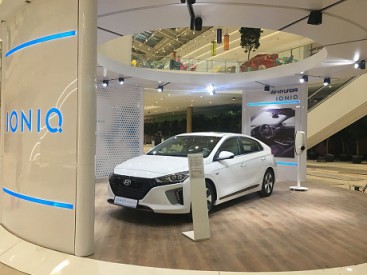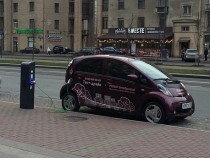Six reasons to choose an electric car today
|
The world is on the verge of cardinal changes in the perception of a product that has recently been considered the subject of luxury by the elite public from Hollywood. Why is electric future?
The rapid emergence of numerous models of electric cars in the "mainstream", observed since the beginning of the XXI century, has become possible thanks to the emergence of efficient batteries and advanced technologies for charging them. To date, the efforts of thousands of scientists and engineers from different countries have developed solutions that have significantly improved the key characteristics of an electrical power plant. Car giants, one after another, declare the transition to the production of electric cars - hoping to repeat the success of Californian Tesla, the company Ilona Mask, who has managed to change the average man’s idea of electric cars for several years. One way or another, the world is on the verge of dramatic changes in the perception of a product that had recently been considered the luxury of the elite public from Hollywood.
|

Iya Gordeeva
Expert in electric transport and charging infrastructure (St. Petersburg)
|
|
First reason: Contribution to environmental improvement.
The solution of the problem of improving the ecology of any large city is inseparable from the problem of purifying the air of streets and courtyards, constantly being poisoned by hundreds of thousands of cars with a traditional internal combustion engine. In conditions of super-dense construction, the situation is aggravated by the presence of noise pollution, which has a negative impact on the vital functions of the human body in the long term. Based on the fact that city traffic in its current form forms the prerequisites for the spread of diseases of the cardiovascular, respiratory and nervous systems, it is necessary to take urgent measures.
In essence, any internal combustion engine absorbs atmospheric air and “burns through” it into a toxic exhaust that concentrates on the surface - in contrast, electric vehicles have zero local emissions, therefore the result of their widespread use will be a drastic decrease in the environmental burden on the environment. Converting a fleet in a city scale with a population of several million people (St. Petersburg, Moscow, etc.) into electric traction will automatically solve the problem of controlling the combustion products of gasoline, diesel and gas engine fuel — it’s more logical to reduce the carbon footprint directly at power plants, avoiding spending on creation of a local exhaust tracking system.
|
He is the chairman of the Association for the development of electric, connected and unmanned vehicles and infrastructure. It is engaged in the development of environmentally friendly transport and infrastructure for it. In his personal blog he will talk about new developments in the electric transport market, legislative initiatives in the industry, problems and solutions to individual problems. And also will share personal experience of owning and testing electric cars and charging stations for them.
|
|
The second reason: Improving energy efficiency
The greater the return on the internal combustion engine engineers are trying to achieve, the higher the degree of electrification of the power plant. A vivid example of this is hybrid cars in which a gasoline engine works in conjunction with an electric motor and a small capacity battery. With impressive research and development costs over the past decades, automakers face a dilemma: the efficiency of traditional heat engines can be improved only marginally, and the adoption of increasingly stringent restrictions on exhaust emissions (95 grams CO2 per kilometer and below) naturally complicates the design. Hydrogen systems suffer from the same fundamental flaw: the very energy-intensive transformations of feedstock by electrolysis or reforming with subsequent losses in the stack of fuel cells negate the benefits of the technology.
However, even the simplest electric car is already ahead of gasoline, gas and hydrogen counterparts in energy efficiency by an average of three to 10 times. Hyundai IONIQ Electric, which consumes 15.7 kW * hours per 100 km in the combined cycle (i.e., 1.7 liters in the gasoline equivalent), can be considered as a reference.
Additionally, it is worth noting the lower level of capital expenditures on the creation of the infrastructure of charging stations in comparison with the refueling terminals for gasoline, gas engine fuel and, in particular, hydrogen. Thus, the cost of a hydrogen fuel dispenser is about 1 million euros, which is several dozen times more expensive than an electric charging station. Charging equipment connects to existing electrical networks, without requiring expensive logistics for the delivery and storage of energy - in contrast to the dispenser, the charging station can be installed in the hotel, shopping center or apartment building. As a result, the process of charging an electric vehicle is much safer than fueling, which helps reduce the risk of fires in crowded places.
By its capabilities, the traction battery is many times greater than the fuel tank or gas cylinder, having a wide range of service functions. First, a high-precision control system monitors the actual state of the cells in real time and balances them; secondly, with the help of active thermoregulation a stable temperature regime is maintained; thirdly, the diagnostic algorithms make it possible to identify in advance the deviations in the parameters for correction. In addition, the mass of the battery pack is used to reduce the center of gravity, to evenly distribute the weight without compromising manageability and stability.
|
Even the simplest electric car is already ahead of gasoline, gas and hydrogen counterparts in energy efficiency, on average, from three to 10 times (the standard in the photo is Hyundai IONIQ Electric).
|
|
The third reason: Optimization of operating costs
As can be seen from the above, the absence in the design of an electric vehicle of a multitude of complex systems and components provides the best indicators of efficiency and reliability. Substantial savings are due to the difference in the cost of fueling and charging with electricity: with an estimated price of 4.5 rubles per kilowatt-hour, 100 km of run cost 50-100 rubles stably, which promises tangible gains in the context of the inevitable rise in retail prices for fuel.
In addition, due to the peculiarities of an electric vehicle device, its owner completely eliminates the need for servicing engine components, a multi-stage gearbox, as well as regular replacement of consumables and automotive components (spark plugs, brake discs, engine oils, fuel and air filters).
According to Nissan and BMW, which occupy the first positions in the volume of production of electric vehicles, the resource of the used lithium-ion batteries is enough for 10-15 years of continuous use - in real, not in laboratory conditions. However, the average (median) power reserve of serial models by 2017 reached 150-200 km, and the maximum exceeded 500 km. In everyday use, it is enough for the car owner to charge him every one to three days where it is convenient: at home, at work, while traveling around the city and beyond.
|
In everyday use, it is enough for the car owner to charge him every one to three days where it is convenient.
Electric transport is the basis for the development of a new high-tech industry.
|
|
The fourth reason: the development of industrial potential
The relevance of supporting autonomous electric transport in the context of import substitution is associated with the tasks of commercializing high-tech solutions, creating new enterprises and thousands of high-tech jobs, as well as developing critical competences.
On the example of economically successful countries, one can clearly see the results of the action of comprehensive initiatives to stimulate demand for electric cars, used as a tool for the development of a number of industries. At the same time, an impetus was given to boosting the production of not only batteries, but also various converter equipment, component base for power electronics, electric drives, charging equipment.
|
Electric vehicles are easy to integrate into the electrical networks of cities and regions. |
|
Fifth reason: Global course on autonomy
Today there is every reason to believe that further improvement of unmanned transport systems will predetermine the spread of qualitatively new urban mobility services within the framework of the concept of “transport as a service” (MaaS). The topic of automated shuttles, serving passengers on a call from a mobile application for a smartphone, perfectly fits in with electric vehicles - moreover, almost all known developments (including SHUTLE from NAMI and KamAZ, Volgabus Matreshka) are.
The combination of a robotic taxi with wireless chargers removes the last barrier to the widespread launch of round-the-clock transportation services, free from human intervention for refueling, whatever it may be. It is obvious that in such a picture of the future waiting for us there is hardly a place for gasoline, gas or hydrogen.
|
In the near future, we are waiting for the emergence of automated shuttles, shuttles, serving passengers on a call from a smartphone. |
|
The sixth reason: New opportunities for energy
Finally, the fundamental "minus" of cars with internal combustion engines and hydrogen power plant is the impossibility or excessive complexity of their integration into electrical networks. The presence of batteries of sufficiently large capacity (from 12 to 100 kW * hours for serial samples) allows the use of electric vehicles as a scalable stationary energy storage in two scenarios.
The first: V2H (vehicle-to-home) - backup supply of electricity to private households, apartment buildings, organizations and enterprises in case of accidents at the facilities of the grid complex. As world practice has shown, with proper implementation of the V2H, electric vehicles are able to successfully replace diesel generators in the case of “blackouts” lasting from several hours to days.
Second: V2G (vehicle-to-grid) - intelligent control of energy flows in active adaptive networks, by means of which bi-directional charging stations for electric vehicles will minimize daily and seasonal peaks, ensuring timely control of the load on the infrastructure in real time. Operatively switching thousands of simultaneously charging cars to the return-to-grid mode, the system uses them for distributed energy storage.
Together with electrification for automobiles, there are quite specific prospects for avoiding the passive consumption of non-renewable resources (hydrocarbon fuel) to actively participate in the production, distribution and storage of "clean energy" obtained from renewable sources - therefore, the synergistic effect of the interaction between the two sectors of the economy is in the interests of strengthening energetic security.
|
|













Payments with: